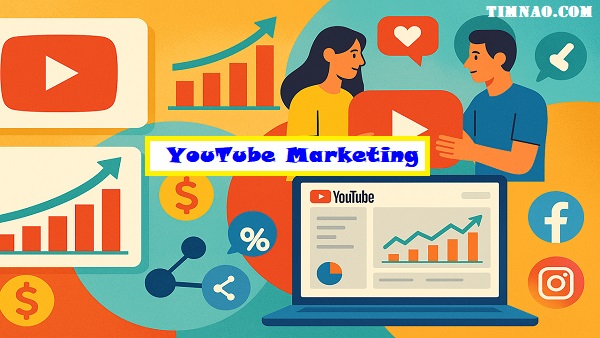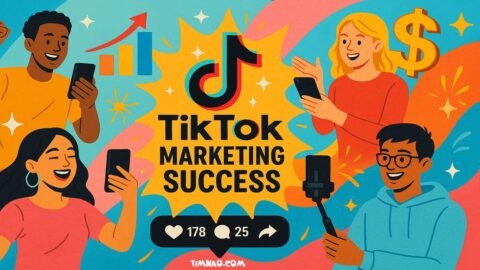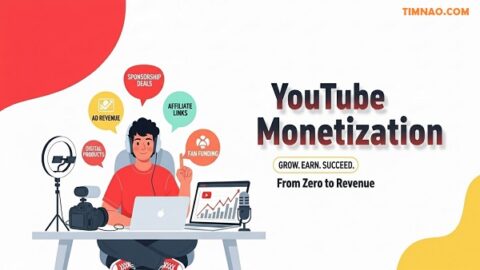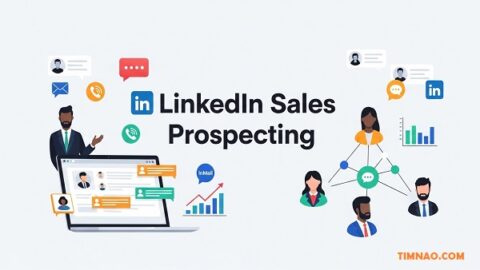10+ Amazing YouTube Marketing Strategies for Business Growth in 2025
YouTube Marketing is no longer just an option for businesses; it’s a powerful engine for growth in today’s digital landscape. With over 2.5 billion active users as of 2024 and billions of hours watched daily, YouTube offers an unparalleled opportunity to connect with your audience, build your brand, and drive serious revenue. It’s the second most visited website globally and the most popular social media platform in the U.S., making it a vital channel for any business aiming for substantial growth.
But navigating the world of YouTube for Business can feel overwhelming, especially for beginners. How do you turn views into customers? How do you stand out in a sea of content? And how do you actually make money?.
Don’t worry! This comprehensive guide, inspired by Bharat Bhuval Nishad’s “YouTube Marketing: Mastering YouTube For Business Growth” and updated with the latest 2025 insights, will walk you through everything you need to know. We’ll break down complex strategies into actionable steps, helping you master YouTube Business Growth, from finding your niche to creating killer ads and building a sales funnel that converts.
Ready to unlock YouTube’s potential? Let’s dive in!
Table of Contents
- Unlocking YouTube: Why It’s a Goldmine for Business Growth
- Finding Your Profitable Niche on YouTube in 2025
- Building & Optimizing Your Business YouTube Channel for Success
- Creating YouTube Videos That Sell (Updated for 2025)
- Expanding Your Reach: Embedding & Cross-Posting
- Going Live: Real-Time Engagement & Promotion
- Ranking Secrets: Getting Your Videos Seen (YouTube SEO Deep Dive)
- Amplifying Results: YouTube Advertising Strategies
- Charting the Course: Your YouTube Sales Funnel
- Monetization Matters: Earning Directly from YouTube
- Top YouTube Marketing Tips for Increased Sales
- The Most Profitable Types of YouTube Videos
- Diversify Your Income: Alternative Platforms & Strategies
- Do’s & Don’ts for YouTube Business Success
- Helpful Tools & Services for YouTube Businesses
- YouTube Business Success Stories
- YouTube Business FAQs
🚀 Unlocking YouTube: Why It’s a Goldmine for Business Growth
Think YouTube is just for cat videos and music? Think again! It’s a dynamic platform designed to connect viewers with content they love, anytime, anywhere. And for businesses? It’s a free ticket to a global audience, available 24/7.
How does it work for businesses?
YouTube provides a space for brands to showcase their personality, expertise, and products through engaging video content. You can educate potential customers, demonstrate your product’s value, differentiate yourself from competitors, and build trust – all without being overly salesy.
Imagine:
- Showing, not just telling: Demonstrate how your product solves a problem.
- Building authority: Share your expertise and become a go-to resource in your niche.
- Connecting in real-time: Host live Q&As, webinars, or behind-the-scenes looks.
- Targeted advertising: Reach your exact ideal customer with YouTube’s powerful ad platform.
- Cost-effective content hosting: Store all your video content for free.
The future is bright for YouTube for Business. User numbers are climbing, new technologies like VR and AR are enhancing the experience, and content marketing is proving more effective than ever. Plus, with 70% of users reporting they bought a product after seeing it on YouTube, the platform offers a direct path to purchase.
🎯 Finding Your Profitable Niche on YouTube in 2025
Before you hit record, you need a plan. The first crucial step? Researching and picking a profitable niche. A niche is simply the specific category or topic your channel will focus on.
Why is Niche Selection Important for YouTube Marketing?
Focusing on a niche helps you:
- Attract a dedicated, relevant audience.
- Become a recognized expert.
- Tailor your content effectively.
- Monetize more easily.
How to Find Your Niche:
- Explore Online Marketplaces: Don’t guess! Look at what’s already selling well. Platforms like ClickBank and JVZoo reveal top-selling categories.
- On ClickBank: Go to the Affiliate Marketplace, search, and sort by “Gravity” to see the hottest offers. Look at the “CAT” section to identify the niche (e.g., Health & Fitness, E-business, Self-Help).
- On JVZoo: Visit the marketplace and check the “Today’s Top Sellers” and “Top Categories” sections.
- Research Related Search Terms (Keyword Research): Once you have a potential niche, find out what terms people actually use to search for related content and products. This is vital for YouTube SEO.
- Use Google: Type your niche keyword into the search bar and note the autocomplete suggestions. These are high-traffic terms.
- Use Youtube: Repeat the process on YouTube. You might find more video-specific terms. Look for keywords like “review,” “tutorial,” “tips,” “how-to,” etc., as these often indicate high traffic.
- Utilize Tools: Tools like vidIQ, TubeBuddy, Google Trends, Ahrefs, and Semrush can provide deeper insights into search volume, competition, and related keywords. Focus on low-competition, high-search-volume keywords, especially when starting out.
- Analyze Your Audience: Who are you trying to reach? Understand their demographics, interests, pain points, and the solutions they seek. Tools like YouTube Analytics (once your channel is running) and Find My Audience can help.
- Assess Monetization Potential: Consider niches with high CPMs (Cost Per Mille/Thousand Views) if ad revenue is a goal. Lucrative niches often include finance, technology, health, online business, and education.
Action: Save all relevant keywords and search terms in a spreadsheet for easy access when creating content.
🛠️ Building & Optimizing Your Business YouTube Channel for Success
Got your niche? Great! Now it’s time to create your YouTube for Business channel – your home base on the platform. It needs to be branded, professional, and optimized for discovery.
Steps to Create & Optimize:
- Create a Brand Account:
- Go to YouTube while logged into your Google Account.
- Click Profile Icon -> Settings -> Add or manage your channel(s) -> Create a channel.
- Enter your business/brand name in the “Brand Account name” field and click Create. Using a Brand Account allows multiple people to manage the channel later.
- Customize Your Channel: Click “Customize channel”.
- Channel Icon: Click the edit icon and upload your business logo. Keep it consistent with your other online profiles.
- Channel Art (Banner): Click “Add channel art” and upload a compelling cover image (Recommended size: 2560 x 1440 pixels, but check current YouTube guidelines). This should visually represent your brand and niche. Ensure it looks good on all devices.
- Video Watermark: Add a small logo that appears on all your videos for consistent branding.
- Optimize the “About” Section: Click the “About” tab.
- Channel Description: This is crucial for YouTube SEO! Write a clear, concise description of your channel and the value you provide. Naturally incorporate your main keywords and related search terms within the first few lines. Explain who you are, what viewers can expect, and how often you post. Add links to your website and social media profiles.
- Links: Add relevant links (website, social profiles, landing pages) that will appear on your banner.
- Channel Trailer & Featured Video:
- Create a short, engaging trailer for new visitors explaining what your channel offers.
- Set a featured video for returning subscribers.
- Organize with Playlists: Group related videos into playlists with keyword-rich titles and descriptions. This improves user experience and watch time. Feature key playlists on your channel homepage.
- Homepage Layout: Customize the sections on your channel homepage to showcase your best content, playlists, and recent uploads.
Consistency is Key: Maintain a consistent visual style (colors, fonts) across your icon, banner, thumbnails, and videos to build brand recognition.
💰 Creating YouTube Videos That Sell (Updated for 2025)
Content is king, but strategic content converts. You need videos designed not just to inform or entertain, but ultimately to guide viewers towards becoming customers.
Uploading & Initial Setup:
- Upload: Go to YouTube Studio -> Create -> Upload videos.
- Video Title: This is critical for YouTube SEO and clicks!
- Include your primary keyword, ideally near the beginning (within the first 60 characters).
- Make it compelling and descriptive. Use numbers, emotional triggers (positive/negative), or highlight benefits. Example: “10 Amazing Gadgets Under $50 (2025 Review)”.
- Add your brand name at the end if appropriate.
- Avoid misleading clickbait.
- Video Description: Your next SEO powerhouse.
- Write a detailed summary (aim for 200+ words if possible, though the document suggests 250 characters for ranking, modern SEO often benefits from more detail).
- Include your primary keyword and 2-3 related keywords naturally in the first few sentences (visible in search preview).
- Add relevant links (product pages, website, social media, related videos).
- Include a clear Call-to-Action (CTA) telling viewers what to do next (e.g., “Visit our website,” “Download the guide,” “Shop now”).
- Use timestamps (chapters) for longer videos to improve navigation and SEO.
- Thumbnail: Your video’s billboard – make it count!
- Use Custom Thumbnails: Always upload a custom thumbnail; don’t rely on auto-generated ones.
- Eye-Catching Design: Use high-contrast colors, bold/readable fonts, and clear imagery. Close-ups of faces showing emotion often work well.
- Relevance: Accurately represent the video’s content.
- Consistency: Maintain a consistent style for brand recognition.
- Text: Use minimal, impactful text that complements the title.
- Tags & Hashtags: Help YouTube categorize your content.
- Tags: Use a mix of broad and specific keywords (8-12 recommended) related to your video. Include your main keyword, variations, and broader topic tags. Tools like RapidTags or TubeBuddy can help.
- Hashtags: Add 2-3 relevant hashtags in the description (e.g., #YouTubeMarketing #BusinessTips).
- Audience Settings: Select “No, it’s not made for kids” unless it specifically is.
- Category & Language: Choose the correct category and language for your video.
Enhancing Engagement & Monetization (Video Elements):
- End Screens: Add elements at the end of your video (last 5-20 seconds) to promote other videos, playlists, your channel subscription, or external websites. Click “Add an end screen” during the upload process.
- Cards: Add interactive cards during your video to link to related content, playlists, channels, polls, or approved websites. Use them strategically to provide value or CTAs without being overly intrusive.
- Captions/Subtitles: Crucial for accessibility and SEO! YouTube can auto-generate captions, but always review and edit them for accuracy. Adding translations expands your reach.
Publishing:
- Choose “Public” visibility.
- You can schedule your video for a specific time (more on optimal timing later) or publish immediately.
- Click “Publish”!. Copy the video link to share.
🌐 Expanding Your Reach: Embedding & Cross-Posting
Don’t let your amazing video sit only on YouTube! Maximize its impact by sharing it across other platforms.
1. Embedding on Your Blog/Website:
Embedding videos drives traffic from your site to YouTube, creates backlinks (good for SEO!), and adds engaging content to your posts.
- Get the Embed Code: In YouTube Studio -> Videos, find your video, click Options -> Get shareable link. (Alternatively, on the video watch page, click Share -> Embed to get the HTML code).
- Create a Blog Post: Write a relevant blog post (around 500 words is good for embedding) summarizing the video’s points or providing context. Include your target keywords in the title and body. End with a CTA inviting readers to watch the video.
- Embed the Video (WordPress Example):
- In the post editor, click the “+” icon to add a block.
- Search for the “YouTube” block.
- Paste the video’s shareable URL (from step 1) into the field and click “Embed”.
- Optional: Add a caption like “Watch on YouTube” and link it directly to the YouTube video page.
- Optimize the Post: Add relevant tags (keywords) and a featured image before publishing.
2. Cross-Posting on Social Media:
Share your video strategically on platforms like Facebook and Twitter (X).
- Shorten Your Link: Use a URL shortener like Bitly. Long YouTube links can look messy, and some platforms might deprioritize direct YouTube links. Copy the shortened link.
- Facebook:
- Go to your Business Page and create a post.
- Write an engaging post: Start with the video title. Add a brief description using keywords and a CTA urging clicks.
- Paste the shortened link. Facebook will generate a preview; remove it by clicking the ‘x’ icon.
- Upload your custom video thumbnail as the post image instead.
- Check everything and click “Post”.
- Twitter (X):
- Create a Tweet.
- Follow the same structure: Video title, description with keywords/CTA.
- Turn your main keywords/search terms into hashtags (#keyword, #SearchTerm).
- Paste the shortened link.
- Upload the custom thumbnail image.
- Check and click “Tweet”.
Important Note for Facebook: While sharing the link works, Facebook’s algorithm often favors native video uploads. Consider uploading shorter clips or trailers directly to Facebook, linking back to the full YouTube video in the comments or description.
🔴 Going Live: Real-Time Engagement & Promotion
Live streaming is a powerful way to connect with your audience authentically, promote products, host Q&As, and generate excitement in real-time.
Setting Up a YouTube Live Stream (e.g., for a Product Launch):
- Access Live Streaming: In YouTube Studio, click Create -> Go Live. Allow camera/mic access.
- Stream Setup (Stream Tab):
- Title: Create a compelling title, perhaps including the product name and “Live Launch” or “Live Q&A”.
- Description: Write a detailed description summarizing the event. Include target keywords and, crucially, the product launch URL or relevant link. Add a CTA encouraging viewers to click the link during the stream.
- Visibility: Set to Public.
- Category: Select the appropriate category.
- Thumbnail: Upload a custom thumbnail relevant to the live event (e.g., product image, event graphic).
- Audience: Select “No, it’s not made for kids”.
- Scheduling vs. Going Live Now:
- Schedule: Enable “Schedule for later,” choose the date and time. This gives you time to promote the live stream link in advance across email and social media. Click “Create Stream”.
- Go Live Now: Disable the schedule option. Make sure you’ve promoted heavily just before going live. Click “Stream”.
- During the Stream: Engage with viewers in the chat, demonstrate the product, answer questions, and periodically remind people to check the link in the description.
Live streaming fosters community and can drive immediate conversions, especially for launches or special offers.
🏆 Ranking Secrets: Getting Your Videos Seen (YouTube SEO Deep Dive)
Uploading isn’t enough; you need your videos to rank high in YouTube and Google search results. While competition is fierce, specific optimization techniques can significantly boost your visibility, even sending new videos to the first page.
Key Ranking Factors & Strategies (2025):
- Keyword Research is Paramount: Understand what your audience searches for before you create content. Use tools to find relevant, low-competition, high-volume keywords.
- Optimize Metadata:
- Title: Include your primary keyword near the start (<60 chars). Make it descriptive and compelling. Use “video keywords” like “Review,” “Tutorial,” “vs,” “How To” when appropriate. Adding your brand name can help uniqueness.
- Description: Write a keyword-rich description (first 2-3 lines are key for preview). Include primary and secondary keywords naturally. Add timestamps, links, and CTAs.
- Tags: Use 8-12 relevant tags (broad and specific).
- Hashtags: 2-3 focused hashtags in the description.
- High-Retention Videos: YouTube rewards videos that keep viewers watching.
- Hook: Grab attention within the first 5-15 seconds. Use strong visuals or intriguing questions.
- Structure: Organize content logically. Use clear chapters/segments.
- Pacing: Maintain a good pace, cut unnecessary fluff.
- Value: Ensure every part of the video provides value or entertainment.
- Longer videos (8+ minutes) can rank well IF they maintain engagement, but don’t artificially inflate length. Short-form (Shorts) also have huge potential.
- Engagement Signals: Likes, comments, shares, subscribes, and saves signal value to the algorithm.
- Encourage Interaction: Explicitly ask viewers to like, comment, and subscribe at natural points. Ask questions to spark discussion.
- Respond to Comments: Build community by replying to comments.
- Click-Through Rate (CTR): A high CTR (percentage of people who click your video after seeing its thumbnail/title in search/suggestions) is vital.
- Compelling Thumbnails: Essential for attracting clicks. Test different thumbnail styles (A/B testing tools can help).
- Intriguing Titles: Work in tandem with thumbnails.
- Audience Retention: How much of your video people watch matters greatly. Analyze your Audience Retention graphs in YouTube Analytics to see where viewers drop off and improve those sections.
- Session Watch Time: YouTube wants to keep users on the platform. Videos that lead viewers to watch more videos (yours or others’) are often favored. Use playlists and end screens effectively.
- Transcription & Captions: Make your content accessible and provide more text for the algorithm to analyze.
- Consistency: Uploading regularly (on a schedule your audience expects) helps build loyalty and signals activity to YouTube.
The “First Page” Trick (Simplified from PDF):
The document suggests a specific method involving long titles with video keywords, brand names, and target terms, combined with detailed descriptions and tags, can achieve immediate high ranking. While instant top ranking isn’t guaranteed and depends heavily on competition, meticulously optimizing all these elements (title, description, tags, thumbnail, content quality, engagement focus) from the moment you publish gives your video the best possible start.
📣 Amplifying Results: YouTube Advertising Strategies
Organic reach takes time. To accelerate YouTube Business Growth and get results faster, investing in paid advertising is essential. YouTube Ads, run through the Google Ads platform, offer powerful targeting options.
Types of YouTube Ad Campaigns:
- Custom Video Campaign (General Promotion/Awareness):
- Goal: Flexible, often uses Maximum Cost Per View (CPV) bidding (pay when someone watches).
- Setup: In YouTube Studio, find the video, click Options -> Promote -> Get Started. This takes you to Google Ads.
- Settings: Define campaign name, budget (start small, e.g., $5-$10/day, and scale), schedule, target languages, and locations.
- Targeting:
- Demographics: Age, gender, income, etc..
- Audiences: Target based on interests, in-market segments (people actively researching products), life events, or custom audiences (website visitors, keyword searchers). Use Find My Audience for ideas.
- Keywords: Show ads to people searching for specific terms.
- Topics: Target based on video content categories.
- Placements: Choose specific channels, videos, or websites (use with caution to avoid limiting reach too much).
- Ad Creative: Select your video. Choose an ad format (e.g., Skippable in-stream ads run before/during/after other videos). Enter your final URL (landing page) and display URL. Add a Call-to-Action.
- Launch: Review and launch the campaign.
- Product & Brand Consideration Campaign:
- Goal: Encourage viewers to consider your product/brand. Often uses “Influence consideration” subtype.
- Setup: In Google Ads, create New Campaign -> Goal: Product & brand consideration -> Type: Video -> Subtype: Influence consideration.
- Settings: Similar to custom campaigns (budget, targeting). Strongly consider targeting In-market audiences here.
- Ad Creative: Video Discovery Ads are often recommended. These appear on the homepage, search results, and watch next feeds, giving viewers more time to consider clicking. Requires a thumbnail, headline, and description.
- Customer Retargeting Campaign:
- Goal: Re-engage people who have already interacted with your channel or videos.
- Setup: In Google Ads -> Tools & Settings -> Audience manager -> Create Remarketing List (+) -> YouTube users.
- List Definition: Name the list. Choose who to retarget (e.g., “Viewed any video as an ad from a channel” is effective for targeting engaged viewers). Select your YouTube channel. Keep default prefill/membership duration initially, adjust later based on conversion data. Click Create.
- Campaign Creation: Create a new video campaign targeting this specific audience list. Show them follow-up videos, testimonials, or special offers.
Effective Ad Strategies for 2025:
- Hook in 5 Seconds: Viewer attention is minimal. Start strong!. Use intriguing questions, bold visuals, or address the audience directly.
- AI & Automation: Leverage Google’s AI for smarter targeting (Predictive Audiences), automated bidding (Performance Max), and budget allocation.
- Interactive & Shoppable Ads: Use features like product links within ads, CTA overlays, polls, and end screens to boost engagement and conversions.
- YouTube Shorts Ads: Tap into the massive Shorts audience (70B+ daily views!) with vertical, fast-paced, engaging ads. Respect the format – capture attention instantly.
- Multiple Formats: Test different ad formats (In-stream, In-feed, Shorts) as they serve different purposes (Educate, Inspire, Entertain).
- Mobile-First & Sound-On: Design ads knowing most views happen on mobile with sound on. Use clear visuals and potentially text overlays.
- Clear Call-to-Action (CTA): Tell viewers exactly what you want them to do.
- Consistent Branding: Ensure your logo/brand is visible early and consistently.
🗺️ Charting the Course: Your YouTube Sales Funnel
A sales funnel visualizes the customer journey, from initial awareness to final purchase. Outlining your YouTube sales funnel helps you create the right content for viewers at each stage.
Stages & Goals:
- Top of Funnel (TOFU) – Awareness:
- Goal: Attract new viewers who may not know your brand. Make them aware you exist.
- Content: Search-friendly, educational, or entertaining videos related to your niche, but not overtly promotional. Think “How-to” guides, industry insights, trend discussions, engaging Shorts. Aim for broad appeal.
- Middle of Funnel (MOFU) – Interest & Consideration:
- Goal: Nurture leads who know your brand. Build trust and showcase your solutions. Drive desire for your product/service. Address potential objections.
- Content: Product explainers (what it is, how it works), detailed tutorials/demos showing benefits, case studies, comparisons, webinars. Storytelling works well here.
- Bottom of Funnel (BOFU) – Action/Conversion:
- Goal: Convert interested leads into customers or trial users.
- Content: Customer testimonials, product demos focusing on ease of use or specific results, special offers/promotions, videos addressing final purchase barriers (e.g., pricing justification, implementation guides). Clear CTAs are crucial.
Content Mix Strategy:
A balanced approach is key. The document suggests this split:
- 40% TOFU Content: Focus on reach and attracting new eyes.
- 40% MOFU Content: Build relationships and showcase value.
- 20% BOFU Content: Drive conversions and close sales.
Action Steps:
- Audit Your Content: Review your existing videos. Which stage does each video primarily serve?. Identify gaps in your funnel.
- Plan Future Content: Strategically plan new videos to fill those gaps and maintain the recommended content mix. Align content creation with your funnel goals.
💸 Monetization Matters: Earning Directly from YouTube
Beyond driving sales for your own products/services, you can earn revenue directly from YouTube through the YouTube Partner Program (YPP).
How Channel Monetization Works:
Once approved for YPP, ads can run on your videos (long-form and Shorts) and live streams. Advertisers pay YouTube, and you get a share of that revenue. YouTube typically takes 45% of ad revenue from long-form videos and 55% from Shorts Feed ads.
YPP Eligibility Requirements (Updated 2024/2025 – Check current YouTube rules as they evolve):
There are now two tiers for accessing YPP features:
- Tier 1 (Access to Fan Funding & YouTube Shopping):
- 500 Subscribers.
- 3 Valid Public Uploads in the last 90 days.
- EITHER 3,000 Valid Public Watch Hours in the past 12 months OR 3 Million Valid Public Shorts Views in the past 90 days.
- Live in an eligible country.
- Active AdSense account linked.
- Two-step verification enabled on Google account.
- Follow all YouTube Channel Monetization Policies (Community Guidelines, Terms of Service, Copyright, AdSense Policies).
- Tier 2 (Access to Ad Revenue Sharing & Full Benefits):
- 1,000 Subscribers.
- EITHER 4,000 Valid Public Watch Hours in the past 12 months OR 10 Million Valid Public Shorts Views in the past 90 days.1
- All other Tier 1 requirements met.
Tips for Getting Monetized:
- Focus on Watch Time & Retention: Create engaging content that keeps viewers watching.
- Quality Content: Produce valuable, original content. Avoid excessive use of unlicensed stock footage/audio.
- Grow Your Audience: Promote your channel consistently to reach the subscriber and watch hour/Shorts view thresholds.
- Follow the Rules: Strictly adhere to all YouTube policies. Avoid “sub4sub” schemes.
- Consistency: Maintain a regular upload schedule.
Applying for YPP:
- Ensure you meet the eligibility criteria for the desired tier.
- Go to YouTube Studio -> Earn tab.
- If eligible, click “Apply now”.
- Review and accept the Partner Program terms.
- Sign up for or link an approved Google AdSense account.
- Wait for review (can take up to a month as humans are involved).
If Not Approved: Review the reasons provided, fix the issues, and reapply after 30 days.
Other Monetization Methods (Beyond YPP Ads):
- Fan Funding: Super Chat, Super Stickers, Super Thanks (allow viewers to pay during live streams or on videos), Channel Memberships (monthly subscriptions for perks). Tier 1 YPP unlocks these.
- YouTube Shopping: Promote your own products or merchandise directly below your videos. Tier 1 YPP unlocks some features, Tier 2 expands options.
- Affiliate Marketing: Promote other companies’ products and earn commissions via affiliate links in your descriptions.
- Sponsorships/Brand Deals: Partner with brands relevant to your audience for dedicated videos or product placements (requires a decent audience size and engagement).
- Selling Your Own Products/Services: Use YouTube to drive traffic to your courses, coaching, digital products, or physical goods.
✨ Top YouTube Marketing Tips for Increased Sales
Beyond the basics, certain tactics can significantly boost your YouTube Business Growth and sales.
- Embrace Short-Form Video (Shorts): With 70B+ daily views, Shorts are crucial for reach and discovery. They can attract new viewers quickly. Keep them fast-paced, hook viewers instantly, and consider trending audio. Retention rates above 80-85% are key for Shorts virality.
- Use Trending Audio: Especially for Shorts, leveraging popular sounds can significantly boost visibility.
- Master Thumbnails & Titles: These are your first impression – make them clickable and intriguing, but not misleading.
- Optimize Posting Times: Analyze your YouTube Analytics (Audience tab) to see when your viewers are most active. Upload consistently during peak times. Experiment to find your sweet spot.
- Engage Relentlessly: Respond to comments, ask questions, run polls, give shoutouts. Build a community, not just an audience.
- Use CTAs Effectively: Don’t be shy! Clearly tell viewers what to do next (subscribe, visit link, comment) at relevant points. Use end screens and cards.
- Leverage Playlists: Guide viewers through related content, increasing session watch time.
- Collaborate: Partner with other relevant creators to cross-promote and reach new audiences.
- Analyze Your Data: Regularly dive into YouTube Analytics. Understand your audience demographics, traffic sources, watch time, retention, and CTR for each video. Use these insights to refine your strategy.
- Be Consistent: Stick to your content schedule and brand voice. Reliability builds trust and loyalty.
🎬 The Most Profitable Types of YouTube Videos
Not all video types are created equal when it comes to driving business results. Focus on formats that align with your sales funnel stages:
- Educational Videos (TOFU/MOFU): Teach something valuable related to your niche. Use infographics or whiteboard animations. Great for attracting initial interest and establishing authority. Can act as lead magnets (e.g., offer a downloadable guide for more info).
- Explainer Videos (MOFU): Explain how a specific product, service, or method solves a problem. Connect the solution (your offer) to the viewer’s pain point simply and clearly.
- Product Videos (MOFU): Showcase your product/service – what it is, how it works, problems it solves. Focus on features and benefits, not a hard sell. Builds interest and consideration.
- Tutorials & Demos (MOFU/BOFU): Show how to use your product or achieve a result with it. Incredibly effective for driving conversions, especially if you solve a common problem easily. Include affiliate links or direct purchase links.
- Customer Testimonials/Case Studies (BOFU): Feature real customers sharing positive experiences and results. Builds social proof and trust, helping hesitant buyers make the final decision.
- Live Streams (All Stages): Engage in real-time, answer questions, demo products, build community.
- YouTube Shorts (TOFU/MOFU): Quick, engaging snippets for discovery, driving traffic to longer videos or specific offers.
💼 Diversify Your Income: Alternative Platforms & Strategies
Don’t put all your eggs in the YouTube basket. Supplement your income and reach by exploring other platforms:
- Patreon: Create a membership program offering exclusive content or perks to your biggest fans for a monthly fee.
- Dailymotion: A YouTube alternative with potentially different audiences and monetization options.
- Brid TV: A video hosting and monetization platform allowing you to embed and monetize videos on your own site.
- Twitch: Primarily live streaming, great for demos, events, and building a highly engaged community. Has its own partnership program.
- Facebook: Upload videos natively for better reach. Leverage Facebook for Creators program for monetization options (ads, brand collabs). Content may have less evergreen potential than YouTube.
Diversification creates more income streams and makes your business more resilient.
✅ Do’s & ❌ Don’ts for YouTube Business Success
Navigating YouTube requires smart practices. Follow these guidelines:
Do:
- Plan: Strategize your content, campaigns, and goals.
- Be Customer-Centric: Create content that helps viewers make informed decisions.
- Entertain & Educate: Combine value with engagement.
- Be Original: Develop a unique brand voice and style.
- Be Consistent: Stick to your upload schedule.
- Engage: Reply to comments, interact with your audience.
- Network: Interact with other relevant channels/businesses.
- Be Visually Appealing: Maintain professional production quality and channel design.
- Use Clear CTAs: Tell viewers what to do.
- Monitor Performance: Track relevant metrics in YouTube Analytics.
Don’t:
- Steal Content: Never copy directly. Repurposing ideas is okay, plagiarism is not.
- Be Misleading: Use accurate titles, thumbnails, descriptions, and keywords.
- Spam: Don’t over-promote or bombard subscribers.
- Force Virality: Focus on consistent value, not just chasing viral hits.
- Aim for Fame (Only): Focus on your niche audience and business goals, not just subscriber count.
- Do Sub4Sub: It builds a fake, unengaged audience.
- Disappear: Announce breaks if needed.
- Publish Boring Corporate Stuff: Keep it engaging, even if it’s about your business.
- Argue: Respond professionally to criticism, ignore trolls.
- Over-Publish: Quality and consistency over sheer quantity.
🛠️ Helpful Tools & Services for YouTube Businesses
Leverage tools to streamline your workflow, gain insights, and improve quality:
- Analytics & SEO: vidIQ, TubeBuddy, Social Blade, Semrush. (Help with keyword research, competitor analysis, channel audits, SEO optimization).
- Video Creation & Editing: OBS Studio (Free screen recording), Wave.video / Veed.io (Cloud-based), Vyond (Animation), Loom (Screen & webcam), Camtasia, ScreenFlow (Mac), Adobe Premiere Pro, Headliner.
- Thumbnail/Graphics: Canva, Pixlr, Adobe Photoshop.
- Social Media Management: Hootsuite, Buffer, Social Champ, Metricool. (Schedule posts, manage multiple platforms).
- Landing Pages & Email: Mailchimp, ConvertKit, etc. (Build email lists and create landing pages). Connect to your shopping cart (e.g., ThriveCart).
- Stock Assets: Epidemic Sound (Music/SFX), Storyblocks (Video/Images).
- AI Tools: Fliki (AI video creation), various AI writing assistants, AI thumbnail generators. 60% of users welcome AI-generated content, and 75% of video marketers use AI tools.
📈 YouTube Business Success Stories
Many brands leverage YouTube effectively:
- Xfinity Mobile: Lifted brand consideration by 113% with targeted video ads showing cost savings.
- Hershey’s: Partnered with creators, generating a 22% lift in purchase intent and $9M+ in sales.
- ASOS: Used interactive video ads to drive a 37% view-through rate and six-figure sales.
- United Airlines: Generated 52% of website conversions via retargeting video ads.
- Backlinko (Brian Dean): Used deep keyword research to generate massive views and traffic to his site.
- Buffer: Optimized videos and targeted keywords, increasing watch time by 61%.
These examples show the power of strategic content, targeted ads, and creator partnerships on YouTube.
❓ YouTube Business FAQs
- YouTube Business vs. Marketing? YouTube Business is the overall strategy of using the platform for business goals (sales, leads); YouTube Marketing involves the specific tactics (SEO, ads) used to achieve those goals.
- Business vs. Creator? A Business uses YouTube to support an external business. A Creator’s primary focus is the YouTube channel and platform-based income.
- Need YouTube if promoting elsewhere? Yes! Diversify reach and tap into YouTube’s massive, unique audience.
- Multiple Channels? Maybe, if you have vastly different product lines or content strategies (e.g., one educational, one promotional).
- Upload Commercials? Yes, as ads. Don’t rely on them as your primary channel content; focus on value-driven videos.
- Organize Content? Yes, use playlists for better navigation and branding.
- Produce vs. Outsource Videos? Outsource if video creation isn’t your core strength or passion, freeing you up for strategy. If you enjoy it and produce quality, do it yourself.
- Budget Needed? Low entry barrier. You’ll need some budget, especially for ads or outsourcing, but you can start small ($5/day for ads) and scale.
- Views/Subscribers Most Important? Not necessarily. Focus on metrics signaling intent and engagement: Watch Time, CTR, Conversions.
The Takeaway: Your YouTube Journey Starts Now!
Mastering YouTube Marketing is a journey, not a destination. It requires strategic planning, consistent effort, data analysis, and a willingness to adapt. By implementing the strategies outlined here – from meticulous niche research and channel optimization to creating funnel-specific content and leveraging targeted ads – you can transform your YouTube channel from a passive presence into a powerful engine for YouTube Business Growth.
Focus on providing value, understanding your audience, staying consistent, and utilizing the right tools. The potential is immense. Good luck!
Reference video:









